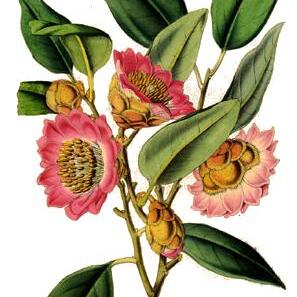Evergreen trees with bisexual flowers. Leaves entire, penninerved, occasionally 3-plinerved. Stipules lacking. Flowers connate, 5-10 in peduncled heads. Bracts 12-20, the lower ones small, the higher ones large, broadly rounded at the apex, forming an involucre, caducous after anthesis. Sepals connate, minute, forming a slightly lobed calyx limb. Petals 0-4, spathulate to obovate, unguiculate, exserted beyond the involucre, only those along the outer margin of the head well developed, the head hence rayed and resembling a 'flower'. Stamens 7-11; filaments long, slender; anthers basifix, oblong, with 4 pollen sacs, 2-celled, dehiscing laterally with 2 septicidal slits producing 4 narrow valves; connective apiculate. Disk absent. Ovary half-inferior, 2-celled, less frequently imperfectly 2-celled or 1-celled; ovules ∞, inserted on the dissepiment; styles 2, long, very slender, only slightly divergent, apically with minute stigmas, caducous in fruit. Fruits 6-10 in heads, only basally connate, woody, ovoid, 2-celled, 4-valved; the receptacle only very slightly enlarged. Seeds 10-20 in each cell, most of them sterile, wingless, 0-1 fertile, about triangular in cross-section or flattened, laterally narrowly winged; cotyledons ovate, flat, fleshy; radicles cylindrical, c. 1/3 as long as the cotyledons; albumen rather copious.
More
Trees or shrubs, evergreen. Leaves alternate, petiolate; stipules apparently absent; leaf blade ovate or lanceolate, leathery, margin entire, venation pinnate, sometimes with 3 basal veins, abaxially usually glaucous. Inflorescence capitate, axillary, pedunculate, usually nodding, 5–8-flowered; involucral bracts 5–many, imbricate, ovate-rounded, outer bracts usually much smaller than inner bracts. Flowers bisexual, zygomorphic. Floral cup very short, enclosing base of ovary. Sepals absent or rudimentary, number not distinguishable. Petals 2–5, well developed only on abaxial side of flower, red, spatulate or oblanceolate, clawed, straight in bud, head as whole rayed and flowerlike. Stamens 4–11, equal to or somewhat shorter than petals; filaments linear; anther thecae 2-sporangiate, each dehiscing by 2 valves; nectariferous disk scales present. Ovary semi-inferior; ovules 12–18 per locule, inserted on septum; styles long, very slender, nearly equal to stamens, apex acute, caducous or persistent in fruit. Capsules dehiscing loculicidally above middle by 4 valves; pericarp thin. Seeds flattened, mostly sterile and wingless, fertile seeds laterally narrowly winged; endosperm rather copious; cotyledons ovate, flat, fleshy; radicle cylindric, ca. 1/3 as long as cotyledons. 2n = 24.

